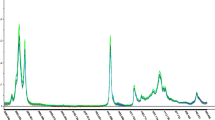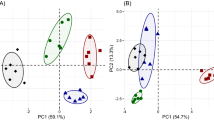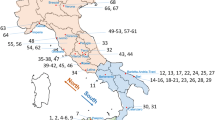Abstract
Olive cultivars present unique chemical properties due to the different ripening conditions and the dielectric factor of the extracted extra virgin olive oil (EVOO) is one of the most acceptable parameters for their evaluation. This study aims at discriminating olive oil samples using their chemical and dielectric properties. Three cultivars of olives: Oily, Yellow and Fishemi, at three ripening stages of unripe, semi-ripe and ripe, harvested using two different machines were tested. The quality characteristics of olive oil include the value of acidity, peroxide, sterol compounds, fatty acid composition and total phenol of the extracted olive oil were measured. The EVOO’s dielectric parameters were measured using a laboratory developed low-frequency device. The measures were done in the range from 0.1 to 10 MHz. The obtained parameters consisted of gain and phase shift voltages that were analyzed by principal component analysis, linear discriminant analysis, decision trees, support vector machine and artificial neural network. Out-of sample validation indicated the artificial neural network had the best performance with correlation coefficient of 0.9479, mean absolute error of 4.762 and root mean square error of 6.6652.The results revealed that the sensor measure followed by a machine learning approach have potential for the industrial application for discriminating the EVOO on the basis of the cultivar and ripening stage of the processed olive.







Similar content being viewed by others
Data Availability
The data that support the findings of this study are openly available.
References
M. Al-Bachir, Comparison of fruit characteristics, oil properties and fatty acid composition of local Syrian Kaissy cv olive (Olea europaea). J. Food Meas. Charact. 11(3), 1011–1018 (2017)
S. Huang, Q. Wang, Y. Wang, R. Ying, G. Fan, M. Huang, M. Agyemang, Physicochemical characterization and antioxidant activities of Chongqing virgin olive oil: effects of variety and ripening stage. J. Food Meas. Charact. 14(4), 2010–2020 (2020)
B. Alowaiesh, Z. Singh, Z. Fang, S.G. Kailis, Harvest time impacts the fatty acid compositions, phenolic compounds and sensory attributes of Frantoio and Manzanilla olive oil. Sci. Hortic. 234, 74–80 (2018)
B. Lanza, F. Amoruso, Measurement of kinaesthetic properties of in-brine table olives by microstructure of fracture surface, sensory evaluation and texture profile analysis (TPA). J. Sci. Food Agric. 98(11), 4142–4150 (2018)
E. Plasquy, J.M. García Martos, M.C. Florido, R.R. Sola-Guirado, J.F. García Martín, Cold storage and temperature management of olive fruit: the impact on fruit physiology and olive oil quality—a review. Processes 9(9), 1543 (2021)
J.M.M. Luna, A.M. Luna, R.E.H. Fernández, Characterization and differentiation between olive varieties through electrical impedance spectroscopy neural networks and IoT. Sensors 20(20), 5932 (2020)
İ Kavdır, M. Burak Büyükcan, F. Kurtulmuş, Classification of olives using FT-NIR spectroscopy, neural networks and statistical classifiers. J. Food Meas. Charact. 12(4), 2493–2502 (2018)
G. Altieri, A. Matera, F. Genovese, G.C. Di Renzo, Models for the rapid assessment of water and oil content in olive pomace by near-infrared spectrometry. J. Sci. Food Agric. 100(7), 3236–3245 (2020)
Altieri, G. (1995). Studio di un sensore NIR per il controllo on-line dei decanter impiegati per l'estrazione dell'olio d'oliva [Development of a NIR sensor for the online control of olive oil extraction by decanter centrifuge] [In Italian]. In: Proceedings of "Seminario di Studio della II e IV Sezione Tecnica dell'AIIA”. Selva di Fasano (BR, Italy). 20–23 September 1995, Rivista di Ingegneria Agraria, quaderno n.18, p. 451–463. (shortly I will provide a DOI)
A. Sanaeifar, A. Jafari, M.T. Golmakani, Fusion of dielectric spectroscopy and computer vision for quality characterization of olive oil during storage. Comput. Electron. Agric. 145, 142–152 (2018)
D.M. Martínez Gila, C. Sanmartin, J. Navarro Soto, F. Mencarelli, J. Gómez Ortega, J. Gámez García, Classification of olive fruits and oils based on their fatty acid ethyl esters content using electronic nose technology. J. Food Meas. Charact. 15(6), 5427–5438 (2021)
G. Yildiz Tiryaki, H. Ayvaz, Quantification of soybean oil adulteration in extra virgin olive oil using portable Raman spectroscopy. J. Food Meas. Charact. 11(2), 523–529 (2017)
S.R. Valantina, Measurement of dielectric constant: a recent trend in quality analysis of vegetable oil-a review. Trends Food Sci. Technol. 113, 1–11 (2021)
A. Reffas, H. Moulai, A. Beroual, Comparison of dielectric properties of olive oil, mineral oil, and other natural and synthetic ester liquids under AC and lightning impulse stresses. IEEE Trans. Dielectr. Electr. Insul. 25(5), 1822–1830 (2018)
J. Beltran Ortega, D.M. Martinez Gila, D. Aguilera Puerto, J. Gamez Garcia, J. Gomez Ortega, Novel technologies for monitoring the in-line quality of virgin olive oil during manufacturing and storage. J. Sci. Food Agric. 96(14), 4644–4662 (2016)
M. Rashvand, M. Omid, H. Mobli, M.S. Firouz, Adulteration detection in olive oil using dielectric technique and data mining. Sens. Bio-Sens. Res. 11, 33–36 (2016)
L. Zhang, J. Chen, B. **g, Y. Dong, X. Yu, New method for the discrimination of adulterated flaxseed oil using dielectric spectroscopy. Food Anal. Methods 12(11), 2623–2629 (2019)
Ö.F. Gamlı, T. Eker, Determination of harvest time of Gemlik olive cultivars by using physical and chemical properties. J. Food Meas. Charact. 11(4), 2022–2030 (2017)
A. Kiritsakis, G.D. Nanos, Z. Polymenopulos, T. Thomai, E.M. Sfakiotakis, Effect of fruit storage conditions on olive oil quality. J. Am. Oil. Chem. Soc. 75(6), 721–724 (1998)
S. Ferreira-Dias, M.M.R. Fonseca, Enzymatic glycerolysis of olive oil: a reactional system with major analytical problems. Biotechnol. Tech. 7(7), 447–452 (1993)
G. Veneziani, S. Esposto, A. Taticchi, S. Urbani, R. Selvaggini, B. Sordini, M. Servili, Characterization of phenolic and volatile composition of extra virgin olive oil extracted from six Italian cultivars using a cooling treatment of olive paste. LWT 87, 523–528 (2018)
L. Cercaci, M.T. Rodriguez-Estrada, G. Lercker, Solid-phase extraction–thin-layer chromatography–gas chromatography method for the detection of hazelnut oil in olive oils by determination of esterified sterols. J. Chromatogr. A 985(1–2), 211–220 (2003)
M.S. Firouz, M. Rashvand, M. Omid, Rapid identification and quantification of sesame oils adulteration using low frequency dielectric spectroscopy combined with chemometrics. LWT 140, 110736 (2021)
T. Lei, X.H. Lin, D.W. Sun, Rapid classification of commercial Cheddar cheeses from different brands using PLSDA, LDA and SPA–LDA models built by hyperspectral data. J. Food Meas. Charact. 13(4), 3119–3129 (2019)
S. Srivastava, S. Sadistap, Non-destructive sensing methods for quality assessment of on-tree fruits: a review. J. Food Meas. Charact. 12(1), 497–526 (2018)
A. Bakhshipour, H. Zareiforoush, I. Bagheri, Application of decision trees and fuzzy inference system for quality classification and modeling of black and green tea based on visual features. J. Food Meas. Charact. 14(3), 1402–1416 (2020)
D. Shen, S. Zhang, W. Ming, W. He, G. Zhang, Z. **e, Development of a new machine vision algorithm to estimate potato’s shape and size based on support vector machine. J. Food Process Eng. 45, e13974 (2022)
W. Zhang, A. Tan, G. Zhou, A. Chen, M. Li, X. Chen, Y. Hu, A method for classifying citrus surface defects based on machine vision. J. Food Meas. Charact. 15(3), 2877–2888 (2021)
F.S. Hashemi-Nasab, H. Parastar, Pattern recognition analysis of gas chromatographic and infrared spectroscopic fingerprints of crude oil for source identification. Microchem. J. 153, 104326 (2020)
H. Karami, M. Rasekh, E. Mirzaee-Ghaleh, Qualitative analysis of edible oil oxidation using an olfactory machine. J. Food Meas. Charact. 14(5), 2600–2610 (2020)
Y. Tahir, A.U. Rahman, S.D. Ravana, An affect-based classification of emotions associated with images of food. J. Food Meas. Charact. 15(1), 519–530 (2021)
B. Wang, J. He, S. Zhang, L. Li, Nondestructive prediction and visualization of total flavonoids content in Cerasus Humilis fruit during storage periods based on hyperspectral imaging technique. J. Food Process Eng. 44(10), e13807 (2021)
D. Aguilera Puerto, Ó. Cáceres Moreno, D.M. Martínez Gila, J. Gómez Ortega, J. Gámez García, Online system for the identification and classification of olive fruits for the olive oil production process. J. Food Meas. Charact. 13(1), 716–727 (2019)
E. Plasquy, M.C. Florido, R.R. Sola-Guirado, J.M. García, Effects of a harvesting and conservation method for small producers on the quality of the produced olive oil. Agriculture 11(5), 417 (2021)
F. Razeghi Jahromi, S.M. Hoseini Mazinani, S. Mohammadi, K. Razavi, B. Shiran, K. Mostafavi, Selecting the optimal time to harvest olive fruit in some Iranian and Mediterranean cultivars based on oil content and composition of fatty acids. J. Crop Prod. Process. 6(19), 85–95 (2016)
E. Seifi, A. Jalali, S. Ebrahimnia, H. Fereidouni, Comparison of biochemical composition of three-cultivar olive oil (Olea europaea L.) in different regions of Golestan province. J. Plant Eco-Physiol. 11(43), 52–65 (2016)
M.L. Hernández, M.D. Sicardo, A. Belaj, J.M. Martínez-Rivas, The oleic/linoleic acid ratio in olive (Olea europaea L.) fruit mesocarp is mainly controlled by OeFAD2–2 and OeFAD2–5 genes together with the different specificity of extraplastidial acyltransferase enzymes. Front. Plant Sci. 12, 345 (2021)
B. Aşkın, Y. Kaya, Effect of deep frying process on the quality of the refined oleic/linoleic sunflower seed oil and olive oil. J. Food Sci. Technol. 57(12), 4716–4725 (2020)
S. Zhang, Y.G. Pan, L. Zheng, Y. Yang, X. Zheng, B. Ai, Z. Sheng, Application of steam explosion in oil extraction of camellia seed (Camellia oleifera Abel) and evaluation of its physicochemical properties, fatty acid, and antioxidant activities. Food Sci. Nutr. 7(3), 1004–1016 (2019)
C. Lammi, N. Mulinacci, L. Cecchi, M. Bellumori, C. Bollati, M. Bartolomei, A. Arnoldi, Virgin olive oil extracts reduce oxidative stress and modulate cholesterol metabolism: comparison between oils obtained with traditional and innovative processes. Antioxidants 9(9), 798 (2020)
B. Xu, L. Zhang, H. Wang, D. Luo, P. Li, Characterization and authentication of four important edible oils using free phytosterol profiles established by GC-GC-TOF/MS. Anal. Methods 6(17), 6860–6870 (2014)
J. Ahmed, L. Thomas, M. Mulla, Dielectric and microstructural properties of high-pressure treated hummus in the selected packaging materials. LWT 118, 108885 (2020)
H. Lizhi, K. Toyoda, I. Ihara, Discrimination of olive oil adulterated with vegetable oils using dielectric spectroscopy. J. Food Eng. 96(2), 167–171 (2010)
S.R. Valantina, D. Susan, S. Bavasri, V. Priyadarshini, R.R. Saraswathi, M. Suriya, Experimental investigation of electro-rheological properties of modeled vegetable oils. J. Food Sci. Technol. 53(2), 1328–1337 (2016)
M. Chen, X. He, Y. Pang, F. Shen, Y. Fang, Q. Hu, Laser induced fluorescence spectroscopy for detection of Aflatoxin B1 contamination in peanut oil. J. Food Meas. Charact. 15(3), 2231–2239 (2021)
C. Ruiz-Samblas, J.M. Cadenas, D.A. Pelta, L. Cuadros-Rodriguez, Application of data mining methods for classification and prediction of olive oil blends with other vegetable oils. Anal. Bioanal. Chem. 406(11), 2591–2601 (2014)
X. Hou, G. Wang, X. Wang, X. Ge, Y. Fan, R. Jiang, S. Nie, Rapid screening for hazelnut oil and high-oleic sunflower oil in extra virgin olive oil using low-field nuclear magnetic resonance relaxometry and machine learning. J. Sci. Food Agric. 101(6), 2389–2397 (2021)
Z. Zou, T. Long, J. Chen, L. Wang, X. Wu, B. Zou, L. Xu, Rapid identification of adulterated safflower seed oil by use of hyperspectral spectroscopy. Spectrosc. Lett. 54(9), 675–684 (2021)
I. Gonzalez-Fernandez, M.A. Iglesias-Otero, M. Esteki, O.A. Moldes, J.C. Mejuto, J. Simal-Gandara, A critical review on the use of artificial neural networks in olive oil production, characterization and authentication. Crit. Rev. Food Sci. Nutr. 59(12), 1913–1926 (2019)
J. Li, L. Sun, R. Li, Nondestructive detection of frying times for soybean oil by NIR-spectroscopy technology with Adaboost-SVM (RBF). Optik 206, 164248 (2020)
H. Karami, M. Rasekh, E. Mirzaee-Ghaleh, Comparison of chemometrics and AOCS official methods for predicting the shelf life of edible oil. Chemom. Intell. Lab. Syst. 206, 104165 (2020)
Q. Zhang, L.L. Zhang, J.G. Xu, G.T. Cui, Rapid and undamaged identification of the Semen cuscutae and its adulterants based on image analysis and electronic nose analysis. J. Food Meas. Charact. 13(4), 3349–3356 (2019)
Q. Du, M. Zhu, T. Shi, X. Luo, B. Gan, L. Tang, Y. Chen, Adulteration detection of corn oil, rapeseed oil and sunflower oil in camellia oil by in situ diffuse reflectance near-infrared spectroscopy and chemometrics. Food Control 121, 107577 (2021)
L.S. Vieira, C. Assis, M.E.L.R. de Queiroz, A.A. Neves, A.F. de Oliveira, Building robust models for identification of adulteration in olive oil using FT-NIR PLS-DA and variable selection. Food Chem. 345, 128866 (2021)
Y. Zhang, H.L. Wu, A.Q. Chen, M.Y. Dong, T. Wang, X.Z. Wang, Y.Q. Yu, Combination of excitation-emission matrix fluorescence spectroscopy and chemometric methods for the rapid identification of cheaper vegetable oil adulterated in walnut oil. J. Food Meas. Charact. 16, 1–12 (2022)
J. Kuang, N. Luo, Z. Hao, J. Xu, X. He, J. Shi, NI-Raman spectroscopy combined with BP-Adaboost neural network for adulteration detection of soybean oil in camellia oil. J. Food Meas. Charact. 16, 1–8 (2022)
J. Wang, Z. Guo, C. Zou, S. Jiang, H.R. El-Seedi, X. Zou, General model of multi-quality detection for apple from different origins by Vis/NIR transmittance spectroscopy. J. Food Meas. Charact. 16, 1–14 (2022)
R. Jamwal, S. Kumari, B. Balan, A.S. Dhaulaniya, S. Kelly, A. Cannavan, D.K. Singh, Attenuated total Reflectance-Fourier transform infrared (ATR–FTIR) spectroscopy coupled with chemometrics for rapid detection of argemone oil adulteration in mustard oil. LWT 120, 108945 (2020)
R. Jamwal, S. Kumari, A.S. Dhaulaniya, B. Balan, D.K. Singh, Application of ATR-FTIR spectroscopy along with regression modelling for the detection of adulteration of virgin coconut oil with paraffin oil. LWT 118, 108754 (2020)
A.M. Jiménez-Carvelo, M.T. Osorio, A. Koidis, A. González-Casado, L. Cuadros-Rodríguez, Chemometric classification and quantification of olive oil in blends with any edible vegetable oils using FTIR-ATR and Raman spectroscopy. LWT 86, 174–184 (2017)
Acknowledgements
This study was carried out within the scope of project IT4NUEVOO—"Impianti e tecnologie innovative per l’estrazione di un nuovo olio extravergine d'oliva nutraceutico e con elevato contenuto di sostanze salutari" funded by Ministero delle Politiche Agricole, Alimentari e Forestali, Rome, Italy, MIPAAFT, D.M. n.30311, 31/10/2018.
Author information
Authors and Affiliations
Corresponding author
Ethics declarations
Conflict of interest
The authors have declared no conflicts of interest in this article.
Additional information
Publisher's Note
Springer Nature remains neutral with regard to jurisdictional claims in published maps and institutional affiliations.
Rights and permissions
Springer Nature or its licensor (e.g. a society or other partner) holds exclusive rights to this article under a publishing agreement with the author(s) or other rightsholder(s); author self-archiving of the accepted manuscript version of this article is solely governed by the terms of such publishing agreement and applicable law.
About this article
Cite this article
Rashvand, M., Altieri, G., Matera, A. et al. Potential of low frequency dielectric spectroscopy and machine learning methods for extra virgin olive oils discrimination based on the olive cultivar and ripening stage. Food Measure 17, 2917–2931 (2023). https://doi.org/10.1007/s11694-023-01836-5
Received:
Accepted:
Published:
Issue Date:
DOI: https://doi.org/10.1007/s11694-023-01836-5




